 Leading Blog | Posts by Month |
 Leading Blog | Posts by Month |
08.31.20

LeadershipNow 140: August 2020 Compilation
See more on
Posted by Michael McKinney at 08:25 AM
08.28.20

Digital Church is Here to Stay: From Social Media to Social Ministry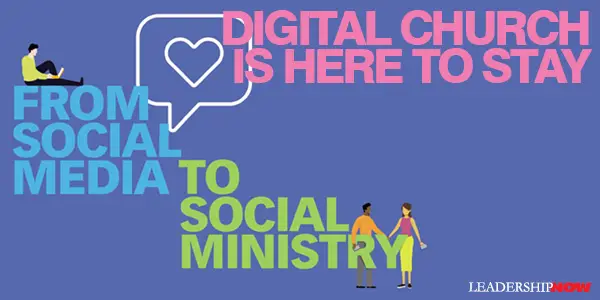
THE RESPONSE to Covid-19 has had a profound effect on what it means to be a church. It has raised a lot of questions. Is a church still a church if it is an online church? Sure, people have been watching online for years, but what about a face-to-face community? Does online attendance lead to engagement? In From Social Media to Social Ministry: A Guide to Digital Discipleship, church leader Nona Jones, answers, “church is more than the worship service.” Jones walks us through the changes and explains why and how to build an effective, truly social media presence. And along the way, we pick up some good leadership lessons, too. Here are some notes from the book: ☙ We live in a post-Christian society. Indicators of a post-Christian society include dramatically decreased percentages of people who pray, study the Bible, claim a religious affiliation, and attend church. Why? According to many of the millennials surveyed, the answer is lack of relevance, or they are saying it doesn’t relate to their priorities and isn’t integrated into their everyday lives. ☙ Dressing down the church service hasn’t solved the problem because the solution didn’t fit the cause. ☙ A social media plan focuses on getting people to the building for a couple of hours every weekend, whereas a social ministry strategy focuses on how to help them grow in their faith through social technology after they leave. ☙ What if effectiveness were also measured by how far the church community reached out instead of only by how much the auditorium fills up? ☙ A social media strategy focuses on building relationships and facilitating connections between and among people so that discipleship can happen. Relationships are the foundation for discipleship. And we don’t build relationships on the weekends during the ninety-minute services we watch together, even if we are together in a building. ☙ Conversation is fundamental to discipleship because discipleship doesn’t happen by tossing biblical content at people. Discipleship is the product of dialogue about how to apply that content to people’s lives in a way that leads to continual transformation. ☙ The Great Commission is about helping people learn God’s truth so they can apply it to their lives. ☙ How videos are titled and categorized is highly important because people use YouTube to learn how to do things or why things are done a certain way, so titling your sermon on forgiveness “December 31, 2019 Worship Service” isn’t going to pop up if someone searches “How do I forgive someone who hurt me?” Instead, title it as an answer to a question to get the best results. ☙ My primary rule of social ministry is this: if you’re to busy to engage, you’re too busy to post. ☙ Go where the people are, and integrate ministry into their routine. ☙ Instead of shaping an online church to fit offline constraints, you have the freedom to shape your online church around its only constraint: your vision. ☙ Facebook is the only truly social media platform. This is why Facebook will form the basis for our social media shift. Build a Facebook campus. ☙ Identify someone already on your team or within your congregation who has the heart of a pastor and a desire to extend the impact of your church beyond the physical boundaries of your community. 
Posted by Michael McKinney at 01:28 AM
08.27.20

Leading Thoughts for August 27, 2020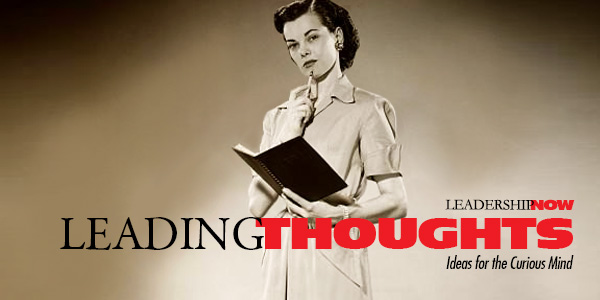
IDEAS shared have the power to expand perspectives, change thinking, and move lives. Here are two ideas for the curious mind to engage with: On how to be happy even in a crazy, unpredictable world: “Some one in five U.S. adults is taking at least one drug for a psychiatric problem; nearly one in four middle-aged women in the United States is taking antidepressants at any given time… You can’t escape it: when scientists test the water supply of Western countries, they always find it is laced with antidepressants, because so many of us are taking them and excreting them that they simply can’t be filtered out of the water we drink every day. Source: Lost Connections: Uncovering the Real Causes of Depression – and the Unexpected Solutions On how thinking about death can lead to a good life: “Thinking about death can actually be a good thing. An awareness of mortality can improve physical health and help us re-prioritize our goals and values, according to a new analysis of recent scientific studies. Even non-conscious thinking about death—say walking by a cemetery—could prompt positive changes and promote helping others. Source: How Thinking About Death Can Lead to A Good Life Look for these ideas every Thursday on the Leading Blog. Find more ideas on the LeadingThoughts index.
Posted by Michael McKinney at 02:30 PM
08.26.20

No, You Can't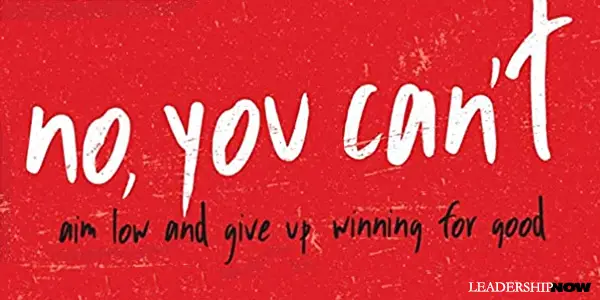
SOMETIMES after you’ve heard it all and seen all of the memes telling you that you can win, you can be anything you want, and the universe is just waiting to hand it all to you, you need a jolt of the very opposite. Sometimes a book comes along and does just that. No, You Can’t: Aim Low and Give Up Winning for Good is the tongue-in-cheek title of Dave Dunseath’s reverse motivation book. No, You Can’t comes in through the back door and gives you— in a humorous way—a shot of reality without personal responsibility, hard work, and intentionality. The unvarnished truth is presented in a such disquieting way that hopefully, the most entrenched pessimists will rethink their approach to life. (Perhaps unintentionally, it also shoots holes in entitlement and the self-esteem movement.) What is a loser? “A loser is anyone who almost touched a star, almost held a dream, or almost got their wish. It’s anyone who doesn’t win and calls it fate or destiny or bad karma or jinxed. Take it from me, once you make your way from Loserindenialus to Loserallthetimeus, you’ll have tons of great excuses to choose from—anytime you need one. All you have to do is let go of what you never were and quit imagining all the things you’ll never be.” Dunseath begins with the Loser’s Creed and a promise: Say it enough, believe it enough, and you’ll feel like you’ve died and gone to Disneyland. You’ll be in a place where you’re never concerned about hard work, a place where you never feel guilty for goofing off all day, a place where nobody expects anything from you, a place where choosing to eat a third corn dog—or not—will be the hardest decision of your day. The book includes the following thoughts that when taken seriously, might reveal areas where some loser thinking that is still lurking in our very own blind spots: What is second place? Second place is merely the highest point a loser can reach. Well, that’s a lot of wrong thinking. It’s jarring. It won’t sit well with you. But that’s the point. The book is a bit of an antidote to the overexposed positive-thinking memes that have become almost invisible on the Internet and fail to register with the negative mindset. They often seem to do more for the poster than the postee. Frequently, another approach is needed. By understanding the loser mindset in all of its forms, we can avoid and help others to avoid the thinking that gets us nowhere. All in all, No, You Can’t is a lesson in human nature. Fortunately, along with all the rationalizations for wrong thinking, anger, and so-called shortcuts, you will find them debunked in a back-handed way. Some of these thoughts found here are the remnants that survive in the back of our minds from the past that come out when times hard or uncertain. The loser-think we all deal with from time to time. Dunseath shows where these thoughts lead, making them easier to extinguish. If you dismiss this book as too negative, you are missing the point. In the end, you begin to see the absurdity of the Loser’s Creed. When taken to its logical conclusion, it makes no sense. Will the day come when I find out that I’m no longer a loser? Dunseath responds: You know what? So many things would have to happen that it’s really not worth worrying over. Your whole life would have to change. You’d have to stop listening to all the people you know who gladly remind you of what’s possible and, more importantly, what is not possible. You’d have to be blind not to see the stumbling blocks and countless obstacles that you’ve learned to avoid so you wouldn’t get hurt. You’d have to see what others don’t, do what others won’t, and believe in what others can’t. He concludes: It’s not complicated. Expect the worst and you’re not only predicting the future, you’re guaranteeing your place in it. So the next time someone suggests you can do something more with your life, be honest and say, “No—no, I can’t, or I would have by now.” That’s really the secret to being everything you’re never going to be. 
Posted by Michael McKinney at 12:44 AM
08.24.20

The Power of Being Directionally Correct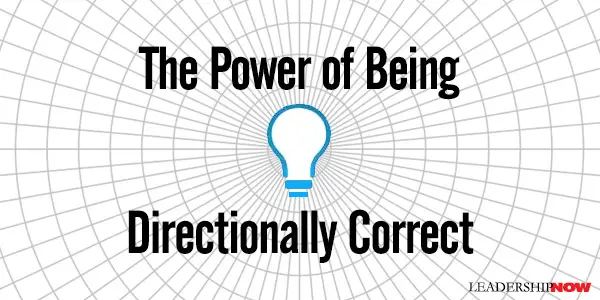
INNOVATION is messy. It’s rarely a straight line from here to there. When doing something new, it’s rare that you know exactly how it is going to turn out. It’s just part of doing something new. It needs to be lead, not managed. Chuck Swoboda, the retired Chairman and CEO of Cree shares the mindset and beliefs that drive innovation in The Innovator’s Spirit: Discover the Mindset to Pursue the Impossible. Innovation is not a manageable process, but it is based on some beliefs and corresponding behaviors of which, he identifies twelve. One such belief is that “it’s better to make a decision with what you know and learn from it as opposed to waiting to act.” It’s better to improve along the way rather than waiting until everything is perfect. It’s what Swoboda calls being directionally correct. What do you do when you realize that “you don’t know what you don’t know”? Think about it for a few minutes. What do you do? What I saw work time and time again is to stop trying to know everything and start doing something. You don’t need to know exactly how it’s going to work out, you only need to be directionally correct. How do you do that? 1. Pick A Direction When you start to pursue a new problem, you can’t possibly know how it’s going to turn out. And you don’t need t know—just start heading in a direction. The point is to have the curiosity to want to know and the confidence to try to figure it out. This is how you develop an innovator’s mindset. It starts with the belief that you can find a way to solve a problem no one else has. 2. Take Your Best Idea To do something better than anyone who came before you, you can’t wait for the perfect answer to come to you. Perfect doesn’t exist. Write down your best ideas and then simply pick one. It really doesn’t matter which one, but you can’t start taking action until you choose. 3. Try It and See What Happens Part of leading innovation is testing your ideas and incorporating new information as it comes. In other words, you run some experiments. It will quickly become clear if the direction you’re pursuing is the right one or not. 4. Use What You Learned to Adjust and Try Again No matter what the result is, after each experiment you have more information. This information can be used to inform the next step and the direction becomes a little clearer. The goal isn’t perfection. It’s finding a better way. It’s excellence. The power of being directionally correct is in knowing you are headed in the right direction without stalling out over, is it right. When Vince Lombardi took over as coach of the Green Bay Packers, he told his team at the first meeting: Gentlemen, we are going to relentlessly chase perfection, knowing full well we will not catch it, because nothing is perfect. But we are going to relentlessly chase it, because in the process we will catch excellence. I am not remotely interested in just being good. Swoboda’s twelve beliefs and behaviors put the innovator’s spirit on a solid foundation and is the path to understanding how to lead innovation in your organization. It begins in the mind. Innovation is more than an invention. It’s something new to be sure, but it also “creates enormous value by addressing an important problem. In other words, inventions are rather common and often collect dust while innovations change the world.” Innovation begins with the belief that “you can find a way to solve a problem no one else could” and staying true to your beliefs. 
Posted by Michael McKinney at 07:22 AM
08.21.20

Touching the Jaguar: How to Transform Your Fear into Action
FACING OUR FEARS is often what is standing between us and success. Touching the Jaguar is a cathartic memoir by John Perkins about confronting the things you fear to make the necessary changes in your life. In this memoir, he touches on the value of altering your perception to change your reality. It’s a valuable lesson expressed in a new way. While working in the Amazon, a shaman told him about touching the jaguar: The jaguar stands on a Perception Bridge “that could convey us from a reality based on preconceived ideas and values to a reality based on new ideas and values. If we are scared off by that jaguar, held back by things we’d been taught in the past or our fear of change, for example, we would not get past the jaguar and cross the bridge. If, on the other hand, we touched the jaguar, recognized the voices, teachings, values, or other barriers that stood in our way, confronted them and altered them, we are empowered to take the actions necessary to cross the bridge into a new reality.” We live with two realities. There is reality itself, and then there is what we perceive it to be. By crossing the perception bridge, we are taken to a new perspective. We can find compassion and empathy from other perspectives. We receive the energy to move forward and take positive action. We can ask what we might do to help others cross the Perception Bridge. By touching the jaguar, we are “recognizing that human reality is molded by our perceptions and that to change ourselves or our world, we must break through the barriers that imprison us in old ways of thinking and acting. If we run from or deny our fears, they will hound us. By confronting them, we take their power.” 
Posted by Michael McKinney at 12:01 AM
08.20.20

Leading Thoughts for August 20, 2020
IDEAS shared have the power to expand perspectives, change thinking, and move lives. Here are two ideas for the curious mind to engage with: Peter Boghossian and James Lindsay call it the Unread Library Effect. Most of us don’t know all we think we know. We rely on borrowed knowledge, ideas and beliefs. We haven’t really checked it out for ourselves. Asking people why they think something can open up their thinking to new knowledge: “Explicitly invite explanations, ask for specifics, follow up with pointed questions that revolve around soliciting how someone knows the details, and continue to openly admit your own ignorance. In many conversations, the more ignorance you admit, the more readily your partner in the conversation will step in with an explanation to help you understand. And the more they attempt to explain, the more likely they are to realize the limits of their own knowledge. This strategy not only helps moderate strong views, it models openness, willingness to admit ignorance, and readiness to revise beliefs.” Source: How to Have Impossible Conversations: A Very Practical Guide George Simon on how people can and do manipulate the truth: “One of the most subtle forms of distortion is being deliberately vague. This is a favorite tactic of manipulators. They will carefully craft their stories so that you form the impression that you’ve been given information but leave out essential details that would have otherwise made it possible for you to know the larger truth.” Source: In Sheep’s Clothing: Understanding and Dealing with Manipulative People Look for these ideas every Thursday on the Leading Blog. Find more ideas on the LeadingThoughts index.
Posted by Michael McKinney at 11:32 AM
08.18.20

Five Frequencies That Are Driving Your Culture (for better or worse)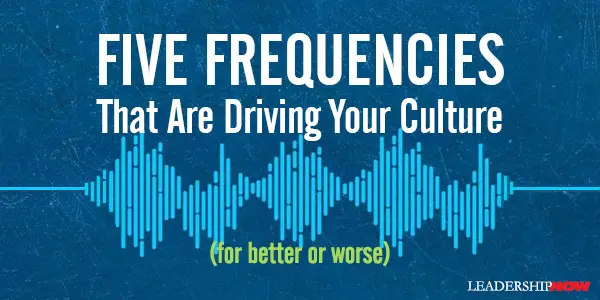
IS YOUR CULTURE holding you back? Are the signals you are broadcasting as a leader, creating the culture you want—you need? Culture experts Jeff Grimshaw, Tanya Mann, Lynne Viscio, and Jennifer Landis say in Five Frequencies that to make a good culture great, leaders must deliberately transmit strong and steady signals. Leaders create culture for better or worse, through the signals they are consciously or unconsciously broadcasting over five frequencies. To change a culture, you need to broadcast a strong, steady signal on each of these frequencies: Their Decisions and Actions Example is everything—especially when it is inconvenient and costs you something. If it is truly a “value,” what are you willing to pay for it? Think in the long-term. “Go long-term greedy.” “This can mean avoiding ethical shortcuts, hiring people smarter than you, delegating more, and helping prepare high performers for success beyond your team.” What They Reward and Recognize Reward the behaviors you want to see more of. “You are responsible for the dysfunctional behaviors that so bother you.” Everyone brings their emotions to work. “Understand and leverage the emotional algorithms that motivate your people.” Understand that it is all relative, scarcity and timing matter, and everyone appreciates being appreciated. What They Tolerate (Or Don’t) “Leaders are ultimately defined by what they tolerate.” Be sure the boundaries are clearly defined as well as the consequences. And don’t make excuses because you don’t want to feel bad or you can’t hold a particular star performer accountable, or because it’s really no big deal. It’s all-important, and consistency is vital. What you tolerate or don’t tolerate is a balance. “When you decide to become more tolerant of some things (like where people work), you must become, if anything, less tolerant of other things (like the work not getting done). As Harvard professor Gary P. Pisano puts it:” A tolerance for failure requires an intolerance for incompetence. A willingness to experiment requires rigorous discipline. Psychological safety requires comfort with brutal candor. Collaboration must be balanced with individual accountability. How They Show Up Informally When you show up, you “bring the weather.” People notice a leader’s tone, mood, and focus. They are weather in any organization. What do kind of weather do you bring? When considering how you show up, the authors advise you to relinquish your raft. They introduce the concept with a story: A traveler on an important journey comes to a raging river. It seems there’s no way to cross. And that’s terrible news because this is an important journey. Fortunately, she spots a rickety old raft on the bank, off in the brush. With trepidation, she pushes the raft into the water, hops on, and amazingly, uses it to reach the other side. She’s able to continue her important journey. She thinks: I may encounter other raging rivers down the path, so I must keep this raft. So she carries the raft on her back as she continues her journey. It’s a heavy raft, and it slows her down. When fellow travelers point this out, she’s incredulous: “You don’t understand,” she says. “If it wasn’t for this raft, I wouldn’t be where I am today!” And she’s right. That’s literally true. The problem is: If she doesn’t put down the raft, she may not get to where she needs to go on her important journey. It’s your baggage. It’s your reactive tendencies that may have worked for you in the past that are no longer getting you where you need to be. Reactive tendencies like going with the flow, control, the need to be the hero, or being overly protective of your ego, eventually bring you diminishing returns. Their Formal Communications Formal communications don’t work on their own, but they serve to reinforce the other four frequencies. Approach your communications as a story to make it memorable. And say it over and over. “Go past the puke point because that’s often the turning point where employees are just starting to truly get it.” Have a backstory. Know where you came from. “Look for stories of people demonstrating the behavior you want to see more of, especially when it’s not easy for them to do so.” Fill the communication vacuums. “Don’t push your people to the black market.” Know, Feel, Do To establish a reliable culture, you need to measure where you are and where you need to go. The authors call it Know, Feel, Do: what employees know, what they feel, and what they do. The authors advise us to work backward and forwards. Looking forward, they ask, “What is the culture that makes this outcome possible and probable? What will employees consistently KNOW? FEEL? DO?” Looking at each of the five signals, what will you need to broadcast to your employees in each of the five signal areas? It is also necessary to look backward and see where your current culture came from. What did each of the signals contribute to your current culture? It will help you to know what to change in order to close the gap from where to are to where you want to be. 
Posted by Michael McKinney at 04:15 PM
08.14.20

The Fear of Looking Stupid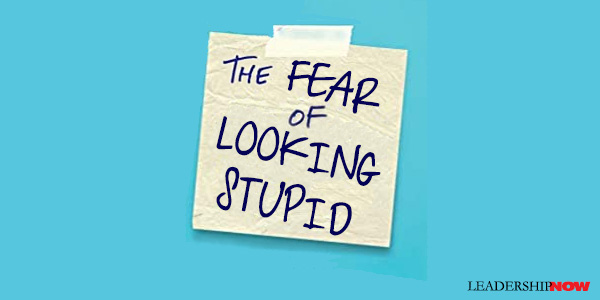
NO ONE likes to look stupid. And it keeps us from trying new things or exploring those crazy ideas and dreams that we have been carrying around. The trick, of course, is getting to the place where you don’t care what other people think of you. And that’s easier said than done. It’s not as simple as telling yourself to just do it. Comedian, entrepreneur, and author of The Art of Making Sh!t Up, Norm Laviolette says the way to get to that place is to slowly step into it as you would train for a marathon. You wouldn’t just run a marathon. You would start with short runs and gradually build up. Maybe you don’t immediately hit the open mic stage, but rather you sign up for an improv class. That’s all, just sign up. You don’t even have to commit in your mind to go, just execute the simplest first step, which is signing up. You don’t even need to tell anyone! Then once you do that, force yourself to go to the first class. No commitments after that. You can apply this to anything. And it is infinitely easier when we realize that other people are not thinking about us as much as we think they are. What are they thinking about? Themselves. Feel liberated yet? We are the ones that give people permission to hold us back from being creative and trying new things. And then there are those who cast doubt when we tell them what we are up to. Laviolette says you need to take control of the conversation. I have found that making a strong declarative statement along the lines of “So, I’m doing X now,” tends to stop other people from offering overly negative judgments about what it is I’m doing. It is easy for people to point out why you shouldn’t begin something, but it is much more difficult for people to tell you why you should stop doing something, especially if you follow up with the reason why you like doing it. Even the biggest blowhard tends to not want to crush someone else’s good vibes. The fear of looking stupid is all in our heads. When we step out, we grow. 
Posted by Michael McKinney at 06:10 PM
08.13.20

Leading Thoughts for August 13, 2020
IDEAS shared have the power to expand perspectives, change thinking, and move lives. Here are two ideas for the curious mind to engage with: Tom Rath on self-absorption: “Life is not about you. It’s about what you do for others. The faster you are able to get over yourself, the more you can do for the people who matter most. Yet external forces keep pulling you toward self-centered pursuits. From books pushing “happiness” to advertisements convincing you that consumption leads to adoration, these messages tempt you to focus inward. That is all a trap (and a load of crap).” Source: It’s Not About You: A Brief Guide Scientist Marie Curie on the importance of self-improvement: “You cannot hope to build a better world without improving the individuals. To that end, each of us must work for his own improvement, and at the same time share a general responsibility for all humanity, our particular duty being to aid those to whom we think we can be most useful.” Source: Pierre Curie: With Autobiographical Notes Look for these ideas every Thursday on the Leading Blog. Find more ideas on the LeadingThoughts index.
Posted by Michael McKinney at 04:36 PM
08.11.20

Full-Spectrum Thinking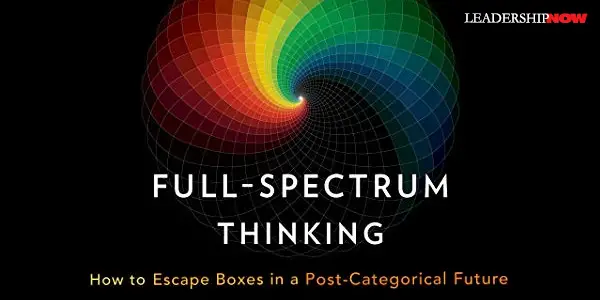
FULL-SPECTRUM THINKING is not common, and never has it been. And as the world becomes more complex, confused, and scrambled, it has never been more critical. Bob Johansen describes full-spectrum thinking as “the ability to seek patterns and clarity across gradients of possibility—outside, across, beyond, or maybe even without any boxes or categories—while resisting false certainty.” In Full-Spectrum Thinking, Johansen writes that “the future will punish categorical thinking but reward full-spectrum thinking.” The future will be a global scramble that will be very difficult to categorize. You will need a full-spectrum mindset to have any hint of what is going on. The scramble will be fraught with toxic misinformation (not necessarily intentional), disinformation (intentional), and distrust. In this future, it will be very dangerous to fit new threats or new opportunities into old categories of thought. Fortunately, new spectrums of thought will become possible in new ways over the next decade. Full-spectrum thinking will be required in order to thrive. Full-spectrum thinking (FST) combines the “nuances of the analog world with the power and scale of digital.” I like that. FST is critical thinking that moves beyond binary, simplistic, categorical thinking. It’s questioning assumptions, stereotypes, and categories. Mindless categorizing is harmful and requires very little thinking. It’s dismissive. They create certainties that block us from seeing possibilities. They are, in a word, constraining. Johansen is not against categories “if they are fair and do no harm. All of us need to create structures and categories of some kind that work for us and for others.” He adds, “Rigid categorial thinking is a bad habit we need to break.” Rigid categorial thinking leads us to certainty, which Johansen and others have declared is the opposite of clarity. And in a narrow sense, I think that is true. Certainty without humility almost certainly, will lead to a lack of clarity. Certainty can blind us to reality—clarity—since we only see things from our own certain perspective. FST demands that we question and take a wider, more inclusive view of the issues before us. But there is a certainty that guides us to clarity and causation and keeps us from adding categories, confusion, and complexity where there are none. And we see that happening all around us. Johansen spends a good deal of the book applying FST to the future of business, technology, our lifestyle, and our sense of meaning. He noes that a forecast is to be evaluated on “whether or not it provokes a better decision in the present.” Adding, “Strategy lives between insight and action” and “every good strategy is based on a compelling insight.” Most companies think in terms of Now, Next, Future. Johansen advises us to shift our strategic orientation to Now, FUTURE, Next. Most of our attention should go to Now. But in a highly uncertain future, we need to look to the future (10 years ahead) for clarity then come back to Next to act in the now. Johansen looks at business development. “Think beyond products. Think especially beyond commodity products where competition is based only on price.” Organizations of the future will move beyond command-and-control to the U.S. Army’s practice of commanders intent or “direction is very clear; execution is very flexible.” Leaders will still be a source of clarity, but the leader will not always be on top. The source of clarity should be grounding, and it should flow up and out across the network. In an interesting chapter on Human-Machine symbiosis, he reimagines the human resources function. Perhaps we need to refer to it as Human-Computing Resources because humans are increasingly augmented by digital resources. Human resource professionals will need the ability to better understand the capabilities of nonhuman and computer-augmented talent. Intelligent coworkers with powerful digital augmentation will be everywhere. And this. As video gaming as a learning medium becomes more widespread, human resource practitioners will need to be “experts in the medium of immersive learning through digital and in-person experiences.” Categories themselves will also become “more fluid and cross-spectrum” as opposed to being binary—in or out. “Diversity will become more important even as it becomes more difficult to categorize.” Creating or finding meaning will become a growth industry. From faith springs hope. Faith has the power to shape our future. Faith grows out of a learning mindset. Faith allows you to navigate your way through things you don’t have all figured out. Faith helps you make your way through fear. Faith is grounded in a sense of humility and openness to learning in an uncertain future. Faith implies a full-spectrum mindset. Rituals and habits help to create meaning. “Rituals are a condensed code of meaning, and repeating the code [like saying “I love you” every day] reinforces the meaning.” Johansen believes that true digital natives (24 or under in 2020) are very good at full-spectrum thinking. “The true digital natives will challenge the social order.” Of course, every generation of young people challenges the social order whether they were brought up on video games and digital content or not. He points out that, “Kids are born with full-spectrum thinking, but adults, schools, and society often force it out of them with education, testing, technology, and culture.” How true. The difficulty for digital natives (like the rest of us) is not relying on soundbites and headlines to form our opinions. Most young people question the status quo and defy categories placed in front of them (or on them) by others. However, they also need to learn to express their thoughts and challenges in an emotionally intelligent way. Full-Spectrum Thinking does make you stop and think about the categories, boxes, labels we place on people and things. We need to learn to think deeper and broader about the issues before us. It is a valuable and cautionary book. Full-spectrum thinking will provide powerful ways to make sense out of new opportunities without assuming that new experiences mirror old categories, boxes, labels, or buckets. Full-spectrum thinking will help people avoid thoughtless labeling of others. Full-spectrum thinking will be a technology-enabled antidote to polarization and simplistic thinking. 
Posted by Michael McKinney at 05:56 PM
08.06.20

Leading Thoughts for August 6, 2020
IDEAS shared have the power to expand perspectives, change thinking, and move lives. Here are two ideas for the curious mind to engage with: Alan Weiss on the fact that most fears are learned as are leadership behaviors, and we have to understand the causes: “We cannot create improved behavior contingently, that is, simply patching up leaks and putting on band-aids. We have to prevent the fearful behavior in the future by eliminating the probable causes. The therapist’s admonition to “face our fears” is really an attempt to find the cause of them.” Source: Fearless Leadership Brian Resnick on what is reality: “Our brains work hard to bend reality to meet our prior experiences, our emotions, and our discomfort with uncertainty. This happens with vision. But it also happens with more complicated processes, like thinking about politics, the pandemic, or the reality of climate change.” Source: “Reality” Is Constructed By Your Brain. Here’s What That Means, And Why It Matters Look for these ideas every Thursday on the Leading Blog. Find more ideas on the LeadingThoughts index.
Posted by Michael McKinney at 06:49 PM
08.03.20

Innovation is Everybody’s Business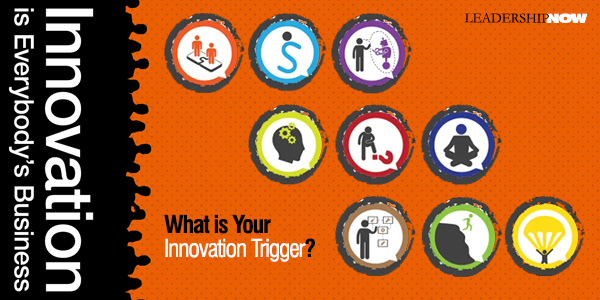
EVERYONE has ideas. Innovation is within each of us. We just need to unlock it. Many of us have experienced negative reactions to our ideas and so tend to hold back sharing new ones. If we are going to be an innovator, we need to have a healthy relationship with change. Change is an opportunity to innovate. Tamara Ghandour defines innovation as “thinking differently about what’s right in front of you to create an advantage” in her book Innovation is Everybody’s Business. There are opportunities in the functions we perform every day. People at all levels of an organization see things differently and can add value to an organization through innovation. Innovation is not for a select few. To help us ignite the innovative mindset that exists inside of all of us, Ghandour has identified nine styles (or triggers) of innovation that relates to how we approach innovation. (You can discover yours by taking the Innovation Quotient Edge (IQE) assessment on her website. The assessment identifies your top two innovation styles and your single dormant trigger.) I believe, like any of our behavioral proclivities, these triggers are not set in stone as they are not part of our DNA, but preferences that we have developed over time. Nevertheless, these styles are helpful for understanding how we approach and think about and execute on ideas, and importantly how we relate and respond to others based on differences in approaches. “Much like the difference in your overall personality,” Ghandour writes, “you have a unique way of innovating. In fact, there are nine distinct styles of innovation. They show up in your personality, preference, work style, behaviors, and actions.” The nine triggers are:
Identifying and understanding these innovation triggers not only helps you to see what gets your creative juices flowing and ignite your innovative flame, but it also helps you to know how you come across to others. That’s very helpful when it comes to presenting your ideas and working within teams. For example, if one of your two predominant innovation triggers is Risk-Taker, your communication style is declarative and opportunistic. Your language reflects words like “I, me, daring, impact, change, disruptive, I challenge, why not.” It is difficult to make the connections necessary for innovative thinking with the stimulus we receive every day. Our minds react by filtering out what doesn’t fit with what we already know or think. Ghandour offers some tips to help us overcome this confirmation bias. 1. Play your own devil’s advocate.
In addition, she offers this constructive advice: Calm the lizard brain down by letting it know the analysis is coming after you innovate. Don’t sabotage your ideas by jumping to judgment too quickly. There’s a time for that. Let your mind explore the possibilities, then do a reality check. 
Posted by Michael McKinney at 03:01 PM
08.01.20

First Look: Leadership Books for August 2020Here's a look at some of the best leadership books to be released in August 2020. Don't miss out on other great new and future releases not listed here.
Creativity isn’t a “nice to have” leadership trait. It’s the key to success in every workplace and all industries. Learn to access yours, now―even if you don’t think you’re a “creative” person. From B-school through the big leagues, the business world often places value on logic and analysis. But on creativity? Not so much. And this, according to Nir Bashan, is a recipe for disaster. What gets the ball rolling when we’re feeling stuck in our careers? Why is my company not growing or reaching higher levels of profitability? What’s the difference between a workable plan and a stroke of genius? The answer is creativity―and it’s the missing ingredient for far too many of us who feel we’re not reaching our creative potential (or doubt we have it in the first place).
Bullshit isn’t what it used to be. Now, two science professors give us the tools to dismantle misinformation and think clearly in a world of fake news and bad data. Misinformation, disinformation, and fake news abound and it’s increasingly difficult to know what’s true. Our media environment has become hyperpartisan. Science is conducted by press release. Startup culture elevates bullshit to high art. We are fairly well equipped to spot the sort of old-school bullshit that is based in fancy rhetoric and weasel words, but most of us don’t feel qualified to challenge the avalanche of new-school bullshit presented in the language of math, science, or statistics. In Calling Bullshit, Professors Carl Bergstrom and Jevin West give us a set of powerful tools to cut through the most intimidating data.
Why do so many organizations, teams, couples, families, and groups who should be working together end up wasting energy on unproductive conflict? Even when everyone has the same general goals, what’s often missing is a deeper alignment based on mutual trust, respect, and empathy. With Radical Alignment, top-level life and business coaches (and happily married couple) Alexandra Jamieson and Bob Gower share their potent method for helping groups to stop clashing and start working together―to jump from “we can’t” to an enthusiastic “hell yes!” The essential tool at the heart of Radical Alignment is the All-In Method: a four-step approach to communication designed to increase clarity, minimize miscommunication, honor each person’s individuality, and build a shared sense of trust and respect for long-term success.
A groundbreaking look at the science of learning—how it's transforming education and how we can use it to discover our true potential, as individuals and across society by a renowned MIT professor. As the head of Open Learning at MIT, Sanjay Sarma has a daunting job description: to fling open the doors of the MIT experience for the benefit of the wider world. But if you're going to undertake such an ambitious project, it behooves you to ask: How exactly does learning work? What conditions are most conducive? Are our traditional classroom methods—lecture, homework, test, repeat—actually effective? And if not, which techniques are? Along the way, Sarma debunks long-held views (such as the noxious idea of "learning styles"), while equipping readers with a set of practical tools for absorbing and retaining information across a lifetime. He presents a vision for learning that's more inclusive and democratic—revealing a world bursting with powerful learners, just waiting for the chance they deserve.
In Humanocracy, Gary Hamel and Michele Zanini make a passionate, data-driven argument for excising bureaucracy and replacing it with something better. Drawing on more than a decade of research and packed with practical examples, Humanocracy lays out a detailed blueprint for creating organizations that are as inspired and ingenious as the human beings inside them. Whatever your role or title, Humanocracy will show you how to launch an unstoppable movement to equip and empower everyone in your organization to be their best and to do their best. The ultimate prize: an organization that's fit for the future and fit for human beings.
The world is changing drastically before our eyes―will you be prepared for what comes next? A groundbreaking analysis from one of the world's foremost experts on global trends, including analysis on how COVID-19 will amplify and accelerate each of these changes. Once upon a time, the world was neatly divided into prosperous and backward economies. Babies were plentiful, workers outnumbered retirees, and people aspiring towards the middle class yearned to own homes and cars. Companies didn't need to see any further than Europe and the United States to do well. Printed money was legal tender for all debts, public and private. We grew up learning how to "play the game," and we expected the rules to remain the same as we took our first job, started a family, saw our children grow up, and went into retirement with our finances secure. That world―and those rules―are over.
 Build your leadership library with these specials on over 32 titles. All titles are at least 40% off the list price and are available only in limited quantities. “Reading is the nourishment that lets you do interesting work.” — Jennifer Egan
Posted by Michael McKinney at 06:05 AM
|
BUILD YOUR KNOWLEDGE


How to Do Your Start-Up Right STRAIGHT TALK FOR START-UPS 
Grow Your Leadership Skills NEW AND UPCOMING LEADERSHIP BOOKS 
Leadership Minute BITE-SIZE CONCEPTS YOU CAN CHEW ON 
Classic Leadership Books BOOKS TO READ BEFORE YOU LEAD |
|